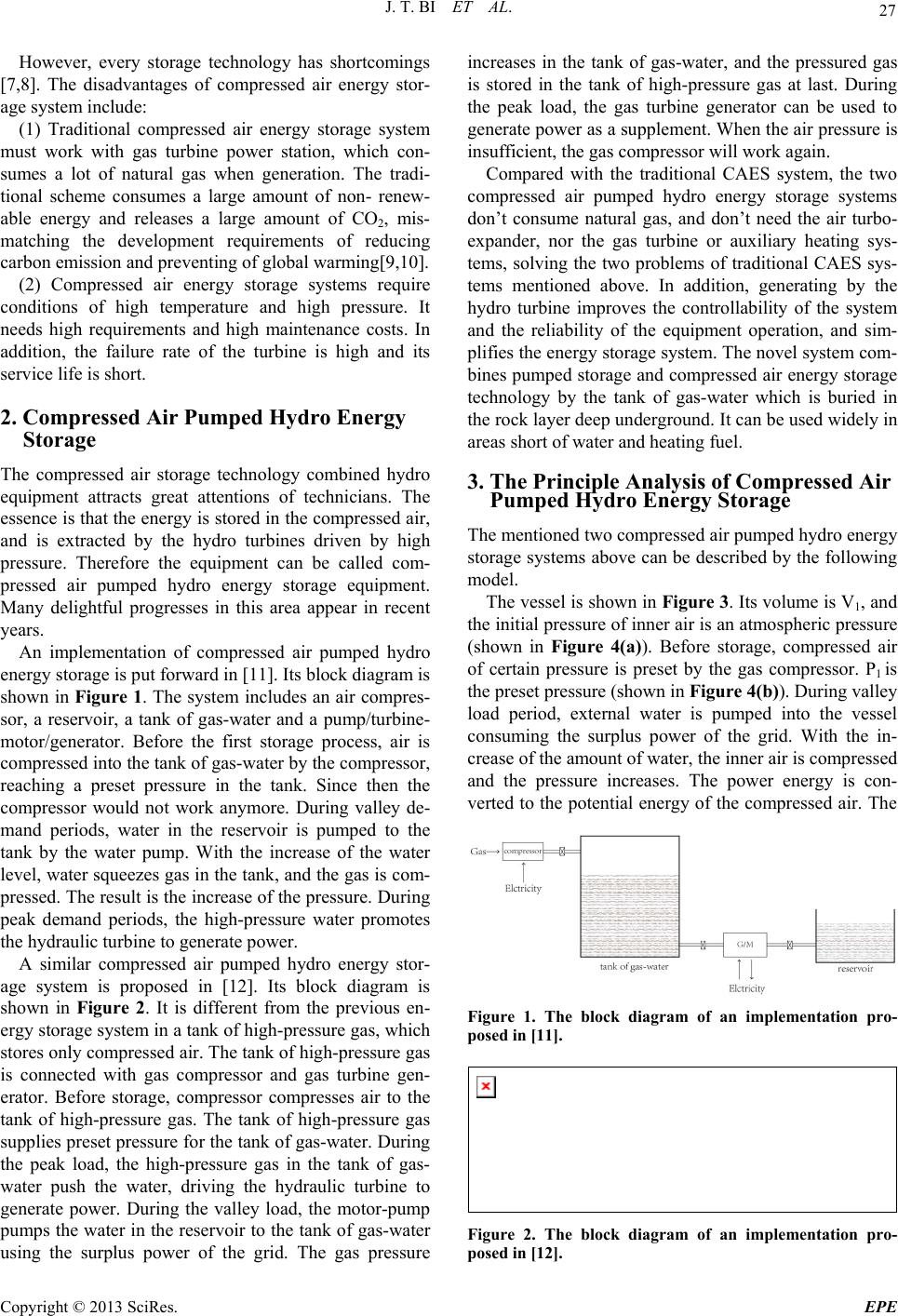
J. T. BI ET AL. 27
However, every storage technology has shortcomings
[7,8]. The disadvantages of compressed air energy stor-
age system include:
(1) Traditional compressed air energy storage system
must work with gas turbine power station, which con-
sumes a lot of natural gas when generation. The tradi-
tional scheme consumes a large amount of non- renew-
able energy and releases a large amount of CO2, mis-
matching the development requirements of reducing
carbon emission and preventing of global warming[9,10].
(2) Compressed air energy storage systems require
conditions of high temperature and high pressure. It
needs high requirements and high maintenance costs. In
addition, the failure rate of the turbine is high and its
service life is short.
2. Compressed Air Pumped Hydro Energy
Storage
The compressed air storage technology combined hydro
equipment attracts great attentions of technicians. The
essence is that the energy is stored in the compressed air,
and is extracted by the hydro turbines driven by high
pressure. Therefore the equipment can be called com-
pressed air pumped hydro energy storage equipment.
Many delightful progresses in this area appear in recent
years.
An implementation of compressed air pumped hydro
energy storage is put forward in [11]. Its block diagram is
shown in Figure 1. The system includes an air compres-
sor, a reservoir, a tank of gas-water and a pump/turbine-
motor/generator. Before the first storage process, air is
compressed into the tank of gas-water by the compressor,
reaching a preset pressure in the tank. Since then the
compressor would not work anymore. During valley de-
mand periods, water in the reservoir is pumped to the
tank by the water pump. With the increase of the water
level, water squeezes gas in the tank, and the gas is com-
pressed. The result is the increase of the pressure. During
peak demand periods, the high-pressure water promotes
the hydraulic turbine to generate power.
A similar compressed air pumped hydro energy stor-
age system is proposed in [12]. Its block diagram is
shown in Figure 2. It is different from the previous en-
ergy storage system in a tank of high-pressure gas, which
stores only compressed air. The tank of high-pressure gas
is connected with gas compressor and gas turbine gen-
erator. Before storage, compressor compresses air to the
tank of high-pressure gas. The tank of high-pressure gas
supplies preset pressure for the tank of gas-water. During
the peak load, the high-pressure gas in the tank of gas-
water push the water, driving the hydraulic turbine to
generate power. During the valley load, the motor-pump
pumps the water in the reservoir to the tank of gas-water
using the surplus power of the grid. The gas pressure
increases in the tank of gas-water, and the pressured gas
is stored in the tank of high-pressure gas at last. During
the peak load, the gas turbine generator can be used to
generate power as a supplement. When the air pressure is
insufficient, the gas compressor will work again.
Compared with the traditional CAES system, the two
compressed air pumped hydro energy storage systems
don’t consume natural gas, and don’t need the air turbo-
expander, nor the gas turbine or auxiliary heating sys-
tems, solving the two problems of traditional CAES sys-
tems mentioned above. In addition, generating by the
hydro turbine improves the controllability of the system
and the reliability of the equipment operation, and sim-
plifies the energy storage system. The novel system com-
bines pumped storage and compressed air energy storage
technology by the tank of gas-water which is buried in
the rock layer deep underground. It can be used widely in
areas short of water and heating fuel.
3. The Principle Analysis of Compressed Air
Pumped Hydro Energy Storage
The mentioned two compressed air pumped hydro energy
storage systems above can be described by the following
model.
The vessel is shown in Figure 3. Its volume is V1, and
the initial pressure of inner air is an atmospheric pressure
(shown in Figure 4(a)). Before storage, compressed air
of certain pressure is preset by the gas compressor. P1 is
the preset pressure (shown in Figure 4(b)). During valley
load period, external water is pumped into the vessel
consuming the surplus power of the grid. With the in-
crease of the amount of water, the inner air is compressed
and the pressure increases. The power energy is con-
verted to the potential energy of the compressed air. The
Figure 1. The block diagram of an implementation pro-
posed in [11].
Figure 2. The block diagram of an implementation pro-
posed in [12].
Copyright © 2013 SciRes. EPE